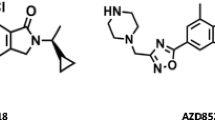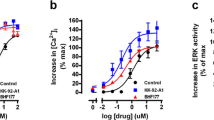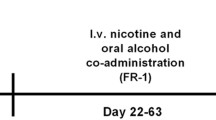Abstract
Rationale
Previous work has indicated a potential role for γ-aminobutyric acid-B (GABAB) receptor agonists in treating drug addiction in humans. Specifically, GABAB receptor agonists decreased cocaine, heroin and nicotine self-administration in rats.
Objectives
The purpose of the present studies was to extend previous findings by assessing the effects of additional GABAB receptor agonists on nicotine self-administration and food-maintained responding, under both fixed and progressive ratio schedules in rats.
Methods
Male Wistar rats were exposed to a progressive ratio schedule where various nicotine doses were made available according to a within-subjects Latin Square design. Additional groups of rats were used to test the effects of the GABAB receptor agonists baclofen and CGP44532 on nicotine self-administration (0.01 and 0.03 mg/kg per infusion) and food-reinforced responding on fixed and progressive ratio (CGP44532 only) schedules.
Results
Nicotine maintained stable self-administration under a progressive ratio schedule with a linear dose-response function (r=0.61). Both CGP44532 and (−)baclofen dose-dependently reduced nicotine self-administration on the fixed ratio schedule, and also decreased food-maintained responding at higher doses. Further, CGP44532 decreased breakpoints for nicotine and food at identical doses under the progressive ratio schedule.
Conclusion
The present data demonstrate that administration of GABAB receptor agonists decreased intravenous nicotine self-administration under both fixed and progressive ratio schedules of reinforcement, possibly reflecting reduced rewarding effects of nicotine. Both baclofen and CGP44532 exhibited specificity for nicotine- versus food-maintained responding on the fixed ratio schedules but not on the progressive ratio schedule (CGP44532 tested only), indicating the potential usefulness of GABAB receptor agonists as therapeutics for smoking cessation.





Similar content being viewed by others
References
Addolorato G, Caputo F, Capristo E, Colombo G, Gessa GL, Gasbarrini G (2000) Ability of baclofen in reducing alcohol craving and intake: II—preliminary clinical evidence. Alcohol Clin Exp Res 24:67–71
Addolorato G, Caputo F, Capristo E, Domenicali M, Bernardi M, Janiri L, Agabio R, Colombo G, Gessa GL and Gasbarrini G (2002) Baclofen efficacy in reducing alcohol craving and intake: a preliminary double-blind randomized controlled study. Alcohol Alcohol 37:504–508
Arnold JM, Roberts DCS (1997) A critique of fixed and progressive ratio schedules used to examine the neural substrates of drug reinforcement. Pharmacol Biochem Behav 57:441–447
Bormann J, Feigenspan A (1995) GABAC receptors. Trends Neurosci 18:515–519
Brebner K, Froestl W, Andrews M, Phelan R, Roberts DCS (1999) The GABAB agonist CGP44532 decreases cocaine self-administration in rats: demonstration using a progressive ratio and a discrete trials procedure. Neuropharmacology 38:1797–1804
Brebner K, Phelan R, Roberts DCS (2000) Effect of baclofen on cocaine self-administration in rats reinforced under fixed ratio 1 and progressive ratio schedules. Psychopharmacology 148:314–321
Brebner K, Childress AR, Roberts DCS (2002) A potential role for GABAB agonists in the treatment of psychostimulant addiction. Alcohol Alcohol 37:478–484
Caine SB, Koob GF (1994) Effects of dopamine D-1 and D-2 antagonists on cocaine self-administration under different schedules of reinforcement in the rat. J Pharmacol Exp Ther 270:209–218
Childress AR, McElgin W, Franklin T, Acton P, O’Brien CP (1999) Impact of GABAergics on brain activity during cue-induced cocaine craving. Soc Neurosci Abstr 25:815
Childress AR, Franklin T, McElgin W, Acton P, O’Brien CP (2000) GABAergics may blunt limbic activation during cue-induced cocaine craving. The College on Problems of Drug Dependence: Proceedings of the 62nd Annual Scientific Meeting Abstracts, San Juan, Puerto Rico
Corrigall WA, Coen KM (1989) Nicotine maintains robust self-administration in rats on a limited-access schedule. Psychopharmacology 99:473–478
Corrigall WA, Coen KM (1991) Selective dopamine antagonists reduce nicotine self-administration. Psychopharmacology 104:171–176
Corrigall WA, Coen KM, Adamson KL, Chow BLC, Zhang J (2000) Response of nicotine self-administration in the rat to manipulations of μ-opioid and γ-aminobutyric acid receptors in the ventral tegmental area. Psychopharmacology 149:107–114
Corrigall WA, Coen KM, Zhang J, Adamson KL (2001) GABA mechanisms in the pedunculopontine tegmental nucleus influence particular aspects of nicotine self-administration selectively in the rat. Psychopharmacology 158:190–197
Dewey SL, Morgan AE, Ashby CR, Horan B, Kushner SA, Logan J, Volkow ND, Fowler JS, Gardner EL, Brodie JD (1998) A novel strategy for the treatment of cocaine addiction. Synapse 30:119–129
Dewey SL, Brodie JD, Gerasimov M, Horan B, Gardner EL, Ashby CR (1999) A pharmacologic strategy for the treatment of nicotine addiction. Synapse 31:76–86
Donny EC, Caggiula AR, Knopf S, Brown C (1995) Nicotine self-administration in rats. Psychopharmacology 122:390–394
Donny EC, Caggiula AR, Mielke MM, Booth S, Gharib MA, Hoffman A, MaldovanV, Shupenko C, McCallum SE (1999) Nicotine self-administration in rats on a progressive ratio schedule of reinforcement. Psychopharmacology 147:135–142
Engberg G, Kling-Petersen T, Nissbrandt H (1993) GABAB-receptor activation alters the firing pattern of dopamine neurons in the rat substantia nigra. Synapse 15:229–238
Fallon JH, Moore RY (1978) Catecholamine innervation of the basal forebrain. IV. Topography of the dopamine projection to the basal forebrain and neostriatum. J Comp Neurol 180:545–580
Fattore L, Cossu G, Martellotta MC, Fratta W (2002) Baclofen antagonizes intravenous self-administration of nicotine in mice and rats. Alcohol Alcohol 37:495–498
Keesey RE, Goldstein MD (1968) Use of progressive fixed ratio procedures in the assessment of intracranial reinforcement. J Exp Anal Behav 11:293–301
Klitenick MA, DeWitte P, Kalivas PW (1992) Regulation of somatodendritic dopamine release in the ventral tegmental area by opioids and GABA: An in vivo microdialysis study. J Neurosci 12:2623–2632
Koob GF (1996) Hedonic valence, dopamine and motivation. Mol Psychiatry 1:186–189
Kushner SA, Dewey SL, Kornetsky C (1997) Gamma-vinyl GABA attenuates cocaine-induced lowering of brain stimulation reward thresholds. Psychopharmacology 133:383–388
Ling W, Shoptaw S, Majewska D (1998) Baclofen as a cocaine anti-craving medication: a preliminary clinical study. Neuropsychopharmacology 18:403–404
Macey DJ, Froestl W, Koob GF, Markou A (2001) Both GABAB receptor agonist and antagonists decreased brain stimulation reward in the rat. Neuropharmacology 40:676–685
Mansbach RS, Chambers LK, Rovetti CC (2000) Effects of the competitive nicotinic antagonist erysodine on behavior occasioned or maintained by nicotine: comparison with mecamylamine. Psychopharmacology 148:234–242
Markou A, Paterson NE (2001) The nicotinic antagonist methyllycaconitine has differential effects on nicotine self-administration and nicotine withdrawal in the rat. Nicotine Tobacco Res 3:361–373
Markou A, Weiss F, Gold LH, Caine SB, Schulteis G, Koob GF (1993) Animal models of drug craving. Psychopharmacology 112:163–182
McGregor A, Roberts DC (1993) Dopaminergic antagonism within the nucleus accumbens or the amygdala produces differential effects on intravenous cocaine self-administration under fixed and progressive ratio schedules of reinforcement. Brain Res 621:245–252
McGregor A, Roberts DC (1995) Effect of medial prefrontal cortex injections of SCH23390 on intravenous cocaine self-administration under both a fixed and progressive ratio schedule of reinforcement. Behav Brain Res 67:75–80
National Academy of Sciences (1996) Guide for the Care and Use of Laboratory Animals. National Academy Press, Washington D.C.
Paterson NE, Markou A (2002) Increased GABA neurotransmission via administration of gamma-vinyl GABA decreased nicotine self-administration in the rat. Synapse 44:252–253
Risner ME, Goldberg SR (1983) A comparison of nicotine and cocaine self-administration in the dog: fixed ratio and progressive ratio schedules of intravenous drug infusion. J Pharmacol Exp Ther 224:319–326
Roberts DCS, Richardson R (1992) Self-administration of psychomotor stimulants using progressive ratio schedules of reinforcement. Neuromethods 24:233–269
Roberts DCS, Andrews MM, Vickers GJ (1996) Baclofen attenuates the reinforcing effects of cocaine in rats. Neuropsychopharmacology 15:417–423
Rose JE, Corrigall WA (1997) Nicotine self-administration in animals and humans: similarities and differences. Psychopharmacology 130:28–40
Shoaib M, Swanner LS, Beyer CE, Goldberg SR, Schindler CW (1998) The GABAB agonist baclofen modifies cocaine self-administration in rats. Behav Pharmacol 9:195–206
Shoptaw S (2000) Outcomes when using the GABA-B agonist baclofen in human cocaine users. Proceedings of the 61st Annual Scientific Meeting. NIDA Res Monogr 180:42–43
Sivilotti L, Nistri A (1991) GABA receptor mechanisms in the central nervous system. Prog Neurobiol 36:35–92
Sugita S, Johnson SW, North RA (1992) Synaptic inputs to GABAA and GABAB receptors originate from discrete afferent neurons. Neurosci Lett 134:207–211
Walaas I, Fonnum F (1979) The distribution and origin of glutamate decarboxylase and choline acetyltransferase in ventral pallidum and other basal forebrain regions. Brain Res 177:325–336
Watkins SS, Epping-Jordan MP, Koob GF, Markou A (1999) Blockade of nicotine self-administration with nicotinic antagonists in rats. Pharmacol Biochem Behav 62:743–751
Willick ML, Kokkinidis L (1999) The effects of ventral tegmental administration of GABAA, GABAB and NMDA receptor agonists on medial forebrain bundle self-stimulation. Behav Brain Res 70:31–36
Winer BJ (1971) Statistical principles in experimental design, 2nd edn. McGraw-Hill, New York
Acknowledgements
This is publication number 14445-NP from The Scripps Research Institute. The authors would like to thank Mike Arends for editorial assistance, and Robert Lintz and Jessica Chevrette for technical assistance. This study was supported by NIDA grant DA11946, DA/NIMH grant U01 MH69062, Tobacco-Related Disease Research Program Grant 12RT-0231 from the State of California, and a Novartis Research Grant to A.M.
Author information
Authors and Affiliations
Corresponding author
Rights and permissions
About this article
Cite this article
Paterson, N.E., Froestl, W. & Markou, A. The GABAB receptor agonists baclofen and CGP44532 decreased nicotine self-administration in the rat. Psychopharmacology 172, 179–186 (2004). https://doi.org/10.1007/s00213-003-1637-1
Received:
Accepted:
Published:
Issue Date:
DOI: https://doi.org/10.1007/s00213-003-1637-1




